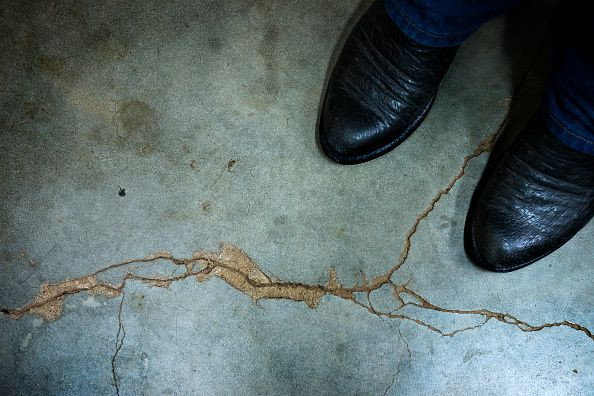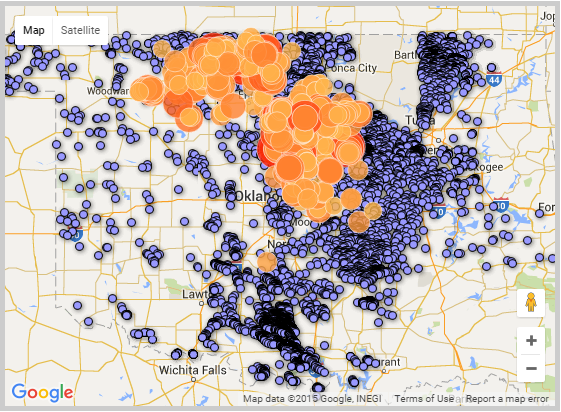Oklahoma Earthquake Swarm: Groups Start Legal Process To Sue Oil Companies Over Wastewater Injections

Environmental groups in Oklahoma are attempting to slow the swarm of earthquakes rattling the state. A coalition Monday began legal moves to stop certain producers from injecting copious amounts of wastewater into the ground, a process scientists say is probably causing the seismic spike.
Public Justice, a public interest law firm, and the New York law firm Weitz & Luxenberg served a “Notice of Intent to Sue” warning on behalf of the Sierra Club’s Oklahoma chapter. The legal notice accuses four energy companies of violating the federal Resource Conservation and Recovery Act by causing some of the earthquake activity. It formally requests the producers “substantially reduce” their wastewater injection over the next 90 days, or face a citizen lawsuit.
“Somebody needs to do something. It’s gone on way too long,” said Johnson Bridgwater, the Sierra Club’s Oklahoma director. “We have people all over north-central Oklahoma who are literally living in fear.”
The groups served the warning to Devon Energy Production Co., New Dominion, Sandridge Exploration and Production and Chesapeake Operating Inc., a subsidiary of Chesapeake Energy Corp. Spokesmen for Devon and Chesapeake declined to comment on the notice. New Dominion and Sandridge did not return requests for comments.
Around 700 earthquakes of magnitude 3.0 or greater have rocked Oklahoma in 2015 -- a more than 300-fold leap from the start of the state’s drilling boom in 2008. The surge puts the Sooner State ahead of California as the earthquake capital of the lower 48 states. Most recently, a 4.4-magnitude quake struck Monday morning in Logan County, near the crucial Cushing oil storage hub.
While no deaths have been tied to the earthquakes, some residents have reported suffering injuries after tremors shook their houses. Insurance claims are rising as foundations crack and bricks crumble across the state. Geologists are also warning of the unknown long-term effects of continually shaking the state.
Jeremy Boak, who directs the Oklahoma Geological Survey, told a state legislative panel last week that the state could see up to 1,000 earthquakes this year. He said that given the current pattern, a 5.0-magnitude tremor is very likely to strike the state in the near term. Oklahoma’s largest earthquake to date, a 5.7-magnitude tremor, struck near the small town of Prague in 2011, causing nearly $1 million in damages.
State and federal scientists have confirmed that Oklahoma’s earthquake swarm is directly tied to the dramatic climb in underground wastewater disposal. But Oklahoma officials and regulators say they are struggling to devise a plan that would curb the earthquakes without hamstringing the energy industry, Oklahoma’s largest employer and a major driver of state tax revenues.
In recent years, oil companies have injected unprecedented volumes of wastewater into the ground as they revisit aging wells, which are filled with brackish water. Drillers use new “dewatering” technologies to suck up the saltwater to reach remaining oil reserves. They then inject the wastewater deep into Oklahoma’s geological formations, where the fluid presses against fault lines in some places. Producers using hydraulic fracturing, or fracking -- another wastewater-intensive process -- are also contributing to the problem.

Oklahoma regulators have made isolated attempts to slow wastewater injections in seismically active areas. In August, the Oklahoma Corporation Commission ordered a 38 percent cut in the amount of wastewater pumped underground by the operators of 23 injection wells spread across a roughly 40-mile stretch northeast of Oklahoma City. Geologists have also highlighted 596 wells -- or 13 percent of the state’s total -- as areas of particular concern for earthquakes.
Still, the advocacy groups behind Monday’s lawsuit notice said the state isn’t acting fast enough to address the accelerating threats to public health and environment from the earthquakes.
“This case is not just about what has happened so far,” said Paul Bland, the executive director of Public Justice, who is based in Washington. “Where are we going to be in three years if this pollution continues unabated? Where would we be in five years? Those are really important things to consider.”
Under the Resource Conservation and Recovery Act, the four energy companies have 90 days to correct the alleged violations detailed in the notice. After that point, the Sierra Club and its legal partners said they intend to file a lawsuit in federal District Court.
Mark Christian, an independent oil and gas consultant in Edmond, Oklahoma, said he opposed the legal effort. A potential lawsuit “will certainly not answer the questions Oklahomans are asking” about the cause of earthquakes, he said in an email. He expressed skepticism about the role injection wells are playing in the seismic upswing, reflecting the industry view that more scientific study is needed to confirm the link.
“Four generations of my family have called Oklahoma home and made their living in the state’s oil fields, so the earthquake issue is important to me,” Christian said. “It’s also important to those [four] oil companies ... because their families live here, too.”
© Copyright IBTimes 2024. All rights reserved.




















